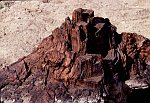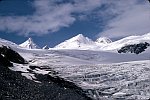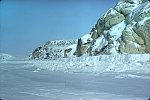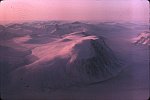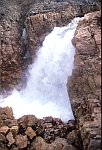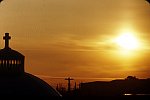The Northern Eco-System
Author: Curt McManus Page 1 | Page 2 | Page 3
Indeed, frost and cold are the primary reasons why there are so few trees in the High Arctic. It is not just the cold but the by-products of the cold that create this absence. Ice crystals carried on the wind, for example, have the power to prune and sheer trees and this explains why there are so few trees and so much ground level vegetation, like Lichens, and cotton grass.
Permafrost is another element, again a by-product of the cold, which prohibits the growth and development of trees and shrubs north of the tree-line. Permafrost describes that part of the soil, usually only a few feet below surface, which remains constantly frozen. Since trees cannot anchor into the soil, there is no chance for survival. This and the fact that trees need ample heat explain the absence of trees in the High Arctic.
Permafrost is important in another way. It contributes in its own way to the formation and development of the many of the lakes and rivers in the North. Since melt-water cannot penetrate the permafrost, it remains on the surface, hence the regions myriad lakes and rivers. The stunning number of lakes, rivers, ponds, and streams also gives rise to an equally stunning number of varieties of ice. Geologists have developed the following list of forms of ice, not meant to be inclusive of all forms:
One of the ice form varieties missing from above is “Ice Rivers”, better know as Glaciers. Glaciers are essentially just that: frozen rivers. Snow accumulates in the mountains; the weight packs the snow into ice and the whole mass begins moving under that weight though they do not move terribly fast. The sprightliest Glacier on record was located on Greenland near Ellesmere Island and moved at a rate of 43 feet per day.
Glaciers only occur in two regions in the North; in the High Arctic regions like Ellesmere Island and in the southern mountain systems of the Yukon.
The cold and the wind play a significant role in shaping the physical world of the north but it is glaciation which is responsible for some of the more spectacular arrangements.
The river system of the North is as equally as impressive as the Mountains. Some of the countries longest and most impressive inland waterways ate found in the Arctic. The Mackenzie, the Root, the Peel and the Nahanni rivers, along with their deltas and tributaries cover much of the sub-arctic region.
And while undoubtedly beautiful, and vitally important to both human and animal life, the vast river system is also home to an unfathomable number of mosquitoes. Naturalist Wayne Lynch says travelers to the Mackenzie River have two options: a)Being eaten alive by mosquitoes or b)Being lost and eaten alive by mosquitoes.
But perhaps the most impressive and unique elements of the Northern environment are those exotic geological curiosities that develop from a combination of the climate conditions mentioned above. Some of these formations are only to be found in the arctic and as such they remain natural wonders very few Canadians will ever get to see.
Drumlins, for example, are a unique by-product of glacial activity. They are low rounded hills formed by retreating glaciers.
Pingos and Palsas are another example of unique arctic formations. The interiors of Pingos and Palsas are made entirely of ice but their exteriors are covered with trees and vegetation.
Kames form when small cavities and hollows from glacial movement are filled.
Nunataks are essentially mountain tips poking up through continental ice-sheets, such as this one found on Devon Island in the High arctic. Drumlins, Kames, Pingos, Palsas and Nunataks are all, generally speaking, unique to the arctic and the Northern environment which formed them.
The North, then, is likely different from what many Canadians imagine it to be. It is not a barren expanse of land void of life. Even the most extreme northern points support a wide variety of plant and animal life and have done so for centuries. Most of these northern points even experience a summer of sorts. In many places, July and August in the north is equivalent to April and June in more temperate climates like southern Canada. Whatever the climate, the North also has the (possible) distinction of breeding the best cribbage players in Canada. Far away from the amenities and entertainments available in southern Canada, explorers and geologists in the arctic many times relied on cribbage to see them through the long hours of available daylight.
The Canadian north sometimes seems as far removed from Canada as one can get without actually leaving Canada. It is different world, with odd plants and even odder looking mammals; it features a sun that refuses to rise and then, later, refuses to set. The ground can even be used as a natural refrigerator. The north is, by most definitions of the word, an exotic place if by that we mean different, out of the ordinary and uncommon. Many people throughout time have viewed the arctic as uninhabitable; a place one would not even want to visit. But the environment which seems to threaten many Canadians is the same environment which has supported human, plant and animal life for centuries.
